To avoid the rain, we spent the morning in the DDR Museum, an interactive museum in a bunker below our hotel on the River Spree. The museum brings alive what it was like to live in East Germany between the years 1949 and 1990, particularly after 1961, when the Berlin Wall was built. DDR stands for “Deutsche Demokratische Republik”, also known as the German Democratic Republic (or GDR).
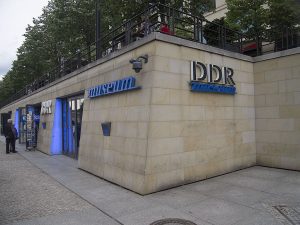
We heard while I was growing up about the deprivations and shortages that people under Communist rule experienced, but to see and touch the really inferior goods that East Germans lived with was really interesting. To experience the museum, you pull out drawers and open cabinets, and play games, and interact with audios and touch screens. One of the most popular objects is a real Trabant, a truly inferior automobile that East Germans scrimped and saved to buy. Altogether, it was a fascinating morning.
I agree with Arjan that this city is very open about its past, but I would like to qualify it slightly. The Germans are very open about what happened to the people, both during the second World War and the years before German reunification. But there is almost no reference to Nazism, and you hear absolutely nothing about Hitler. The only East German soldiers you hear about in regards to the Berlin Wall are those that defected. But the Germans can be very proud of the rapid recovery from a very troubled history.
In the afternoon, after the sun came out for a while, we took a long bus ride to the Kaiser Wilhelm Memorial Church in the old West German city center at Kurfürstendamm. Due to intense afternoon traffic, we spent over an hour driving past a lot of the same places from the land side we saw on our river cruise the day we arrived—mostly government sites built since German reunification after the Berlin Wall came down.
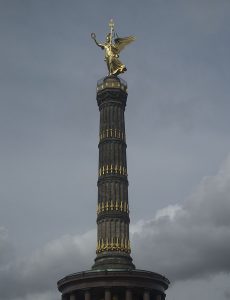
One of the monuments we passed was the Siegessäule (Victory Column), built to commemorate the Prussian victories in the Danish-Prussian War (1864), the Austro-Prussian War (1866), and the Franco-Prussian War (1870). It has a striking gold statue of winged Victory at the top.

Our ultimate destination was the Kaiser Wilhelm Memorial Church. The church consists of a bombed out ruin of the original church and two rather ugly appendages, a new chapel and a bell tower. The original church, one of the most ornate Protestant churches anywhere, was built by Kaiser Wilhelm II in honor of his forefathers.
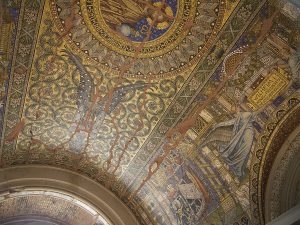
The church was destroyed by an allied bombing raid in 1943, making a wreck of a formerly glorious piece of architecture. The steeple was broken off, there are mortar holes on the exterior, cracks are visible in the entry hall ceiling, the rose window is a gaping hole, and most of the church is gone forever. Even the statue of Christ from the altar was damaged, a loving, welcoming arm broken off near the shoulder.
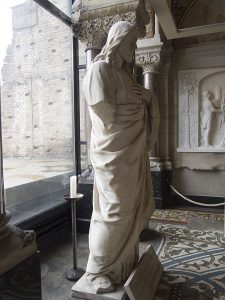
Rather than tear the church down, the hull of the entrance hall has been left in the center of the complex as a memorial and a reminder of the cost of war.
We went inside the new church, which has a strikingly blue stained-glass interior and were lucky enough to hear the organist practicing on the new organ, but the tragedy of the loss of the original church left a most powerful impression.
The efficient S-Bahn transit train whisked us back to our hotel in half the time it took us to get there by bus. I love the metro system here. The cars ride more smoothly than any transit system I have experienced anywhere else I’ve been.
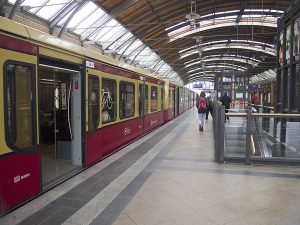
A huge downpour arrived just at dinnertime, so we ate at HEat, the trendy restaurant in our hotel. It was good, but not outstanding, and Arjan said the wine was way over-priced. The weather tomorrow is predicted to be glorious.
Photographs © 2016 P.J. Gardner. All rights reserved.